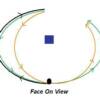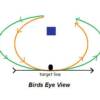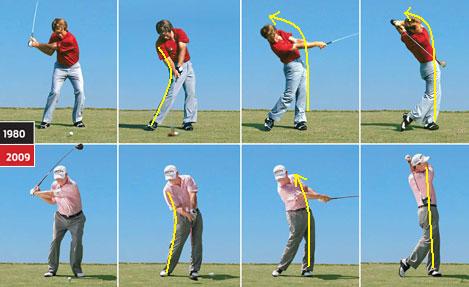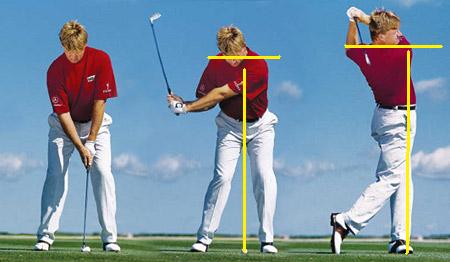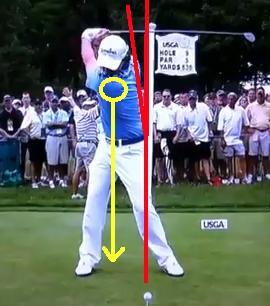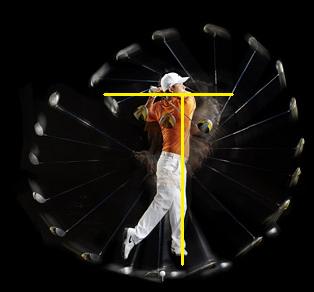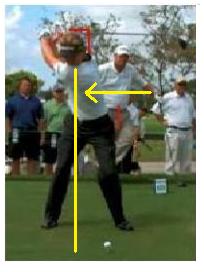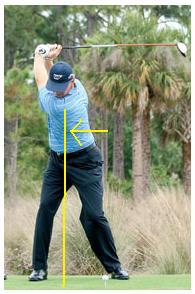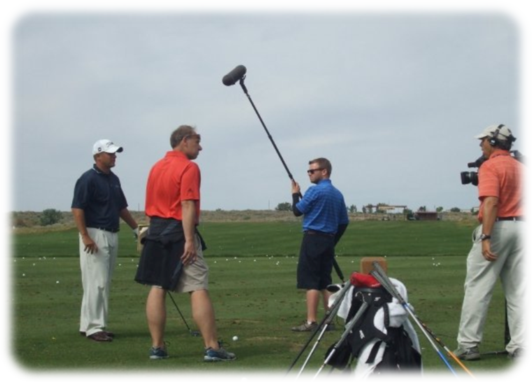Forward Swing Arc: After the transition is reached, your body weight will start to transfer to the foward foot....to the target. This weight transfer is a lateral motion. Remember, the club head starts moving towards the target so does your body weight (directly reletated). That being said, do not let the upper body and lower body work independently. It is a simultaneous and coordinated movement between the upper body (torso & shoulders) and the lower body (hips and legs) to start the foward swing. Your shoulders, torso, and hips initiate the forward swing simultaneously. Now, if you remember back in the Shoulders section of this website I stated there are 2 kinds of golfers in this planet: the 'over the top' ers, and the 'under spin & flip' ers. You need to realize which category you are before you use one of my prescibed drills and run with it.
Cover at Impact: The lateral weight transfer continues right up to and through impact. The wide forward swing arc is a result of the proper 'transition' movement and the lateral dynamic weight transfer to your foward foot. The picture below speaks VOLUMES of how the golf swing and our perception of the golf swing has changed. People say you can't teach an old dog new tricks. Tell that to Tom Watson. Tom was the best golfer on the planet at one time, arguably. Then, his putter started to fail him around his mid to late 30's and continued until his senior career. This was a huge problem for Tom. He was by his peer's admissions, not real good tee to green, but was the best with a wedge and a putter. So.. his plan b was ... fix his golf swing which he did by his mid 40's. And boy did he ever. If you can remember his mid to late 40's on tour, he was arguably the best ball striker out there (and still is on the senior tour). He would have won 3 majors from age 45 to 48 if his putting confidence came back...but it didn't. And we will never forget what the golf gods did to him on the last hole of the British Open at age 59 to eventually lose (hit 2 perfect shots and missed the green). Now, what was Tom's golf swing change in his mid 40's? He told the viewing public very simply... 'I started to level my shoulders at impact and everything changed'.
Dynamic Transfer of Weight
I have noticed that some form of weight transfer is needed to perform any athletic motion. You watch a major league pitcher and you will observe the body weight transferring from one foot to the other while the throwing motion is being performed.... ditto for a quarterback motion. Bowling, tennis, and volleyball incorporate weight transfer. Golf is no different. Athletic motions require a dynamic transfer of weight. Do not confuse this motion with the improper weight shift referred to as swaying (I will explain the differences between the two). The dynamic transfer of weight is vital to the On Plane Golf Swing. Weight transfer provides the 'wide arc' which is the epicenter of the On Plane Golf Swing.
Backswing Arc: A very simple thing to remember about shift. The club head and your weight shift are directly related. The direction of the club head is the same direction of your weight transfer. During the backswing... your weight transfers to your rear foot. During the forward swing... your weight transfers to your forward foot. Your body weight starts about 50/50 on each foot (from the face on view). At the finish of the backswing, the weight distribution will be around 55/45 (55% on rear foot/45% on forward foot) with the driver swing (less with other other clubs). That being said your head will actually move off the ball a bit ... away from the target (on the back swing) with the driver, maybe 3 to 5 inches (less with other clubs). How is this different from a 'sway'? When a golfer 'sways' instead of shifting his weight, the hips will move laterally away from the target on the back swing. When you shift properly on the back swing, your hips don't move laterally, they rotate around your spine.
A note about the left arm during the back swing. The left arm (right hand golfer) is extended fully and does not break. This will encourage your weight to shift away from the target on the back swing. The left arm will remain rigid/straight until the golf ball has left the clubface on the forward swing. The firmness of the left arm is extremely important for clubhead speed to be maximzied and the arc to remain wide.
BACK SWING DYNAMIC TRANSFER OF WEIGHT (DRIVER SWING)
- Hips rotate and do not move laterally away from target
- Rear leg is anchor (does not move laterally)
- Rear leg remains flexed (does not lock)
- Upper Body moves laterally away from target and rotates
TOP OF THE SWING CHECK (DRIVER SWING)
- Hips rotated and did not move laterally
- Upper body (waist up) moved off the ball
- Upper body rotated around the spine
- Head position is now 3 to 5" from starting position
with driver swing
As you can see the sequence pics of Tom Watson, you'll notice several element's of the On Plane Swing. Tom's impact position is more vertical than the 1980 picture. Also realize, that he is hitting a driver (hitting on the upswing). By hitting on the upswing he won't 'cover' the ball as much at impact compared to an iron swing (like Els below). Secondly, Tom's willingness to level his shoulders (or attempting to) has created a much more efficient impact position (2009 pic). The end result is better golf shots. Ernie Els does it as good as anyone....
PERFECT IMPACT!
- Center of gravity is much more on 'top' of ball at impact (Cover)
- Shoulders are level at impact
- Complete vertical and level finish position
Much less lower back strain
Finish Position: As stated previously, the dynamic transfer of weight continues right up through impact and to the completion of the golf swing. In my experience, almost every student I teach has a difficult time with this for a couple of reasons. We were taught initially .... 'head behind ball at impact', 'drive with the lower body', 'fire the hips', ect. All of these thoughts or perceptions lead to the upper body ending in the reverse C finish position. This simply does not work with the On Plane Golf swing. When I work on the forward swing weight transfer with my students, I simply show them that if your 'head' moves to the target during the forward swing...everything usually takes care of itself. Obviously, it's easier said than done. This video drill will help with this motion.
WEIGHT SHIFT DRILL
- Back swing: Shift weight to rear foot
- Forward swing: Shift weight to front foot
- Result: Level shoulder position at impact and finish and vertical body finish
HOW TO FOLLOW THROUGH DRILL
Which 'Cover the Ball' drill is for you? This is very important. For us to have 'level' shoulders at impact we must realize which transition fault we currently have. If you are an 'over the top' transition golfer choose the video drill on the left. If you are an 'under spin & flip' transition golfer use the video drill on the right.
Rory McIlroy
Ernie Els
(double click to expand video)
(double click to expand video)
Learn how to stop the 'Under/Spin/Flip' move
(double click to expand)
"What Swing Transition Are You?
(double click to enlarge)
Learn how to stop the 'Over the Top' move
(double click to expand)
Luke Donald
